Poisonous and inedible species of fungus scaly
Carbon-loving flake (Pholiota highlandensis)
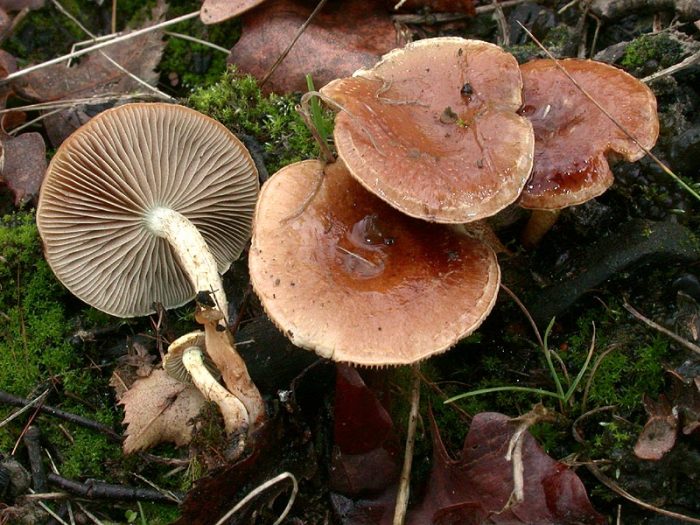
Inedible mushroom.
The diameter of the cap is 2-6 cm, the shape is convex, then convex-prostrate. The skin is orange-brown or ocher-brown in color with a light edge, the surface is sticky, shiny, scaly. The pulp is thin, yellowish-brown in color, the taste and smell are not expressed. The leg is 3-6 cm high, 0.4-0.8 cm in diameter, cylindrical, thickens towards the base. Above it is yellowish, below it is dark brown, scaly.
Distributed in the northern temperate zone, grows in groups from June to early winter.
Fire scales (Pholiota flammans)
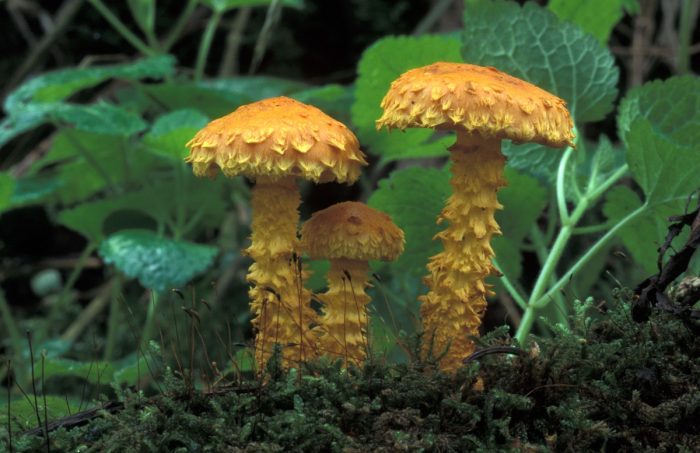
Inedible mushroom.
The diameter of the cap is 2.5-7 cm, the shape is hemispherical or conical in a young mushroom, with age it becomes convex and plano-convex, the edge is bent. The surface is covered with dry bright yellow scales, slimy, yellow-orange in color. The pulp is yellow-orange, brownish in the stem, has an earthy odor, the taste is insipid or bitter. The leg is 3-7 cm high, up to 1 cm thick, in mature mushrooms it is hollow, with a ring, below the ring it is covered with bright yellow scales.
The species is widespread in Eurasia; it grows on the dead wood of coniferous trees.
Description of cinder flakes
The caps of young specimens are like hemispheres; over time, they open, but not completely. The diameter of the cap is 2-6 centimeters. The color of the cap is indeterminate - orange-brown. In wet weather, the surface of the cap becomes covered with mucus. Often dirt adheres to the cap, which is associated with the growing conditions of these mushrooms. The edges of the cap are often wavy, with scraps of bedspread, their color is lighter in comparison with the middle. In the center of the cap is a wide truncated tubercle. The skin of the cap has fibrous scales.

The flesh is firm and rather thick. Its color is light brown or light yellow. The pulp does not differ in its special taste and smell. The plates are adherent, they are located infrequently. In young mushrooms, the plates are grayish; with age, they become clay-brown, since spores ripen in them. The spore powder is brown.
The lower part of the leg is covered with brown fibers, and the upper part is the same color as the cap. The height of the leg reaches 6 centimeters, and the diameter is up to 1 centimeter. The leg is covered with small red-brown scales. The trace from the ring is almost invisible, it is a brownish zone, but it quickly disappears.

Distribution of cinder flakes
These mushrooms begin to bear fruit already in May, and this process continues with variable frequency until October. They are found on burnt wood and old fireplaces.
Evaluation of the taste of cinder flakes
Usually, cinder flakes are classified as inedible species, since they have practically no culinary value. But sometimes these mushrooms are used as conditionally edible - they are boiled or pickled.

The similarity of cinder flakes with other species
If we take into account the distribution places of these mushrooms, then they cannot be confused with other species, since similar mushrooms do not settle on burning.
Other mushrooms of this genus
Scale golden - edible mushroom. The mushroom cap is 5-18 centimeters. Its shape changes from broadly bell-shaped to flat-round. The structure is flat. Its color is rusty yellow or golden. The surface of the cap is covered with flaky reddish scales. The leg is dense, up to 10 centimeters long and up to 1.5 centimeters thick. The young fungus has a fibrous ring, but it disappears with age. The color of the leg is rusty-brown or yellow-brown.
Golden scales grow in large groups. They settle on the trunks of deciduous trees, they can also grow next to them. Fruiting time is August-September. These mushrooms are common throughout Russia.

Destructive scales are an inedible mushroom. The diameter of the cap reaches 20 centimeters. Its shape is convex-rounded. The color of the cap is yellowish white or brown. The surface is dotted with fibrous white scales.The leg is up to 15 centimeters long and up to 3 centimeters in diameter, the same color as the cap, with flaky large white scales. There is a white ring on the stem, which disappears when the mushroom is fully ripe.
These mushrooms grow on dying deciduous trees and stumps. They bear fruit in groups from August to November.
Harm and contraindications to the use of golden scales

The main contraindications for golden flakes is the inability to collect them. If the basket is filled with mushrooms grown in an environmentally polluted area or near busy roads, there is a high risk of intoxication. Fruiting bodies absorb heavy metal salts, toxins and carbon monoxide.
You can not introduce royal mushrooms into the diet with pancreatitis and diseases of the stomach or intestines in the acute stage - with the improvement of the condition, a single use does not affect the state of health.
Children under 3 years old and pregnant women should not feast on golden flakes. Children do not have enough enzymes for processing, and during pregnancy, you should choose lighter foods, do not put yourself at risk - the accumulation of harmful substances cannot be predicted.
An absolute contraindication to the use of royal honey agaric is an individual intolerance to mushrooms or fruit bodies of this species.
The golden flake is not combined with alcohol. With abundant alcoholic libations, these mushrooms are not suitable for snacks.
Symptoms may appear:
Abdominal cramps and pain, nausea and vomiting;
Difficulty breathing and tachycardia;
Tremor of the limbs.
Severe intoxication causes a coma and a disorder of consciousness - when severe symptoms appear, it is necessary to call an "ambulance".
The increase in alcohol intoxication is due to meconic acid, which is contained in the composition of the mushroom pulp. This substance is a derivative of opium. Joint action with alcohol and causes dangerous symptoms.
Does the royal mushroom have dangerous counterparts?
Golden scales are almost impossible to confuse with another mushroom because of its original appearance - bright color and pointed scales. These are the statements of experienced mushroom pickers, but beginners should know what false mushrooms look like. It will help them distinguish between photos and descriptions of dangerous doubles.
Moth, or alder flake (Latin Pholiota alnicola). This species also belongs to the genus Scale. Prefers alder and birch stumps. The size of the mushrooms is much more modest than that of the royal mushroom. The hats are yellow, no more than 5-6 cm in diameter, the legs are 4-8 cm long and rather thin - only 0.4 cm thick. It has a bitter taste and an unpleasant odor.
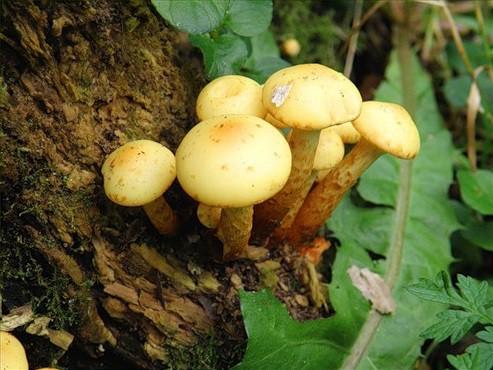
Flame scales (lat. Pholiota flammans). The fungus has a very bright color, which is difficult to confuse with other members of the genus. The scales on the cap are arranged in the form of regular concentric circles. They are much lighter than the cap itself, in contrast to the royal mushroom, where the scales, on the contrary, are very dark. In addition, fire flake grows singly, is quite rare and mainly in coniferous and mixed forests. The mushroom has a very bitter taste and an unpleasant odor. And although it is not poisonous, it is not eaten.
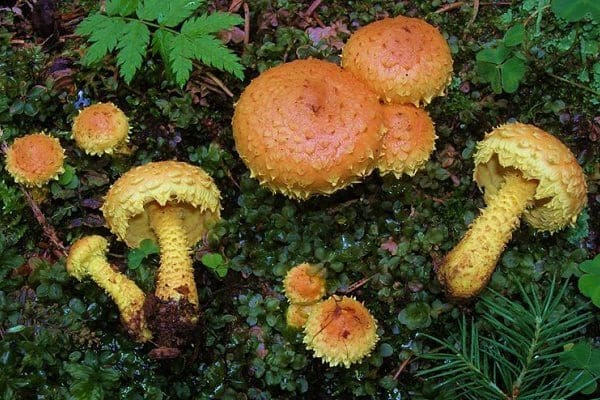
Scaly mucosa (Latin Pholiota lubrica). Refers to conditionally edible mushrooms. It is found in coniferous forests, loves rotted wood. There are not so many scales on a large brown or yellow hat, moreover, they are light in color. In wet weather, like the royal mushroom, it is covered with mucus. However, the stem of the fungus is hollow inside, and the adult fruiting bodies do not have a ring under the cap.

Cinder flakes (Latin Pholiota highlandensis). The size of the mushroom is very modest in comparison with the royal mushroom. The cap has a darker, brown color with fibrous scales. It is often covered in mud. Its edges are lighter, with scraps of bedspread.The leg is covered with brown fibers at the bottom. Cinder flakes prefers old fireplaces and burning, loves charred wood. Other mushrooms similar to her are not found in such places.
Scale golden: what a mushroom looks like
The scientific name of the royal honeydew is golden scaly (Latin Pholiota aurivella). Belongs to the genus Scale of the Strophariev family. It is edible, but different from the usual mushroom and its dangerous counterparts.
The mushroom is large in size and has a wide-bell-shaped cap covered with scales. In young fruiting bodies, it is about 5-10 cm in diameter. With age, the cap opens and becomes flat-round, sometimes it can reach 18-20 cm in size. Its color is yellow-golden. From above it is covered with red-brown scales. The plates are yellowish-white, hidden under the veil, but over time they darken and become brownish-brown. The pulp in the cap is whitish with a pleasant smell and original taste.
The stem of the mushroom is rather tall, dense and covered with scales. In adult fruiting bodies, it reaches 7-10 cm in length and 1-1.5 cm in diameter. In young mushrooms, the stem is connected to the cap by a fibrous ring, which later breaks, and its remains can be seen along the edge of the cap. The pulp of the scales is golden light yellow.
Useful properties of golden flakes
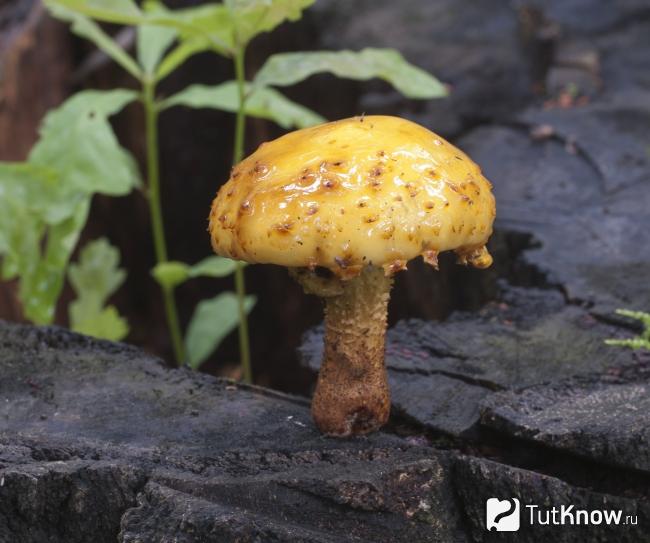
The benefits of golden scales were noticed not only by healers, but also by those who regularly include mushrooms in the seasonal menu and prepare for the winter.
Action on the body:
- Improve impulse conduction in nerve fibers regardless of the depth of occurrence;
They have bacterial and antifungal activity due to mucus, which is on the surface of the cap and is absorbed into the pulp;
Eliminate lethargy, fatigue, increase overall tone and performance;
Promote the strengthening of immunity, stimulate the production of phagocytes;
Prevent the occurrence of strokes and heart attacks by stabilizing cerebral circulation;
Reduce the likelihood of developing thrombophlebitis, atherosclerosis and varicose veins;
Improves the general condition of diabetes;
Prevents the growth of benign neoplasms.
In the pulp of the fruit body of royal honey agarics there is a substance squarrozidine, which inhibits the enzyme xanthine oxidase - because of it, urate salts are deposited in the joints of the joints. If you have a history of gout, it is recommended to eat mushrooms at least 4 times a week. This will help reduce the frequency of attacks and reduce pain if they do occur.
Cinder scale (Pholiota highlandensis) - Mushrooms of Siberia

Current title
| Index Fungorum | Pholiota highlandensis (Peck) Quadr. & Lunghini |
| MycoBank | Pholiota highlandensis (Peck) Quadraccia & Lunghini |
Systematic position
Fungi, Basidiomycota, Agaricomycetes, Agaricales, Strophariaceae, Pholiota
Etymology of the species epithet
Highlandensis - alpine.
Synonyms
- Agaricus highlandensis Peck, Ann. Rep. N.Y. St. Mus. 24: 67 (1872)
- Naucoria highlandensis (Peck) Sacc., Syll. fung. (Abellini) 5: 845 (1887)
- Flammula carbonaria (Fr.) P. Kumm., Führ. Pilzk. (Zerbst): 82 (1871)
- Pholiota carbonaria (Fr.) Singer, Lilloa 22: 517 (1951)
- Flammula highlandensis Peck, Ann. Rep. Reg. N.Y. St. Mus. 50: 138 (1898)
- Pholiota highlandensis (Peck) A.H. Sm. & Hesler, The North American species of Pholiota: 287 (1968)
- Pholiota persicina P.D. Orton, Trans. Br. mycol. Soc. 91 (4): 567 (1988)
Other names: Alpine flakes, Coal-loving flakes.
Despite the lack of striking characteristic features, this type of scale is easy to define: the smooth, shiny copper-brown caps of P. highlandensis are a common sight on last year's burnt fields and old fireplaces, often in the company of other carbotroph species.
Habit
Fruit body: Cap and stem (agaricoid)
Hat
The cap is 20-50 (70) mm in diameter, initially convex, then prostrate, with a small tubercle. The surface is yellow-ocher-brown, reddish, sticky in wet weather, shiny in dry weather. The edge of the cap with fleecy remnants of the bedspread is slightly lighter, sometimes tucked up.
The plates are adherent, gray-yellowish at a young age, then darken to red-brown, the edge is finely serrated.
Leg
The leg is 20 - 50 mm long, 3 - 7 (10) mm in diameter, with an annular zone, above which it is whitish or yellowish, below it is darker, light brown, covered with light scales along its entire length, forming a zigzag pattern.
Pulp
Microscopy
Spore powder is red-brown.
Spores (6.5) 7.0 - 8.0 (9.0) × 4.0 - 5.0 μm, Q = 1.5 - 2.0, broadly ellipsoid, smooth, with a distinct embryonic pore.
Basidia 22 - 35 × 6.0 - 9.0 μm, clavate, 4-spore.
Pleurocystids (38) 40 - 65 (70) × (6) 7 - 15 μm, bottle-shaped or fusiform, transparent or with yellow content.
Cheilocystids are similar in shape to pleurocystids but smaller in size, (20) 30 - 50 (52) × (6) 7 - 12 (15) microns.
Pileipellis consists of colorless cylindrical hyphae 2.0 - 3.0 µm in diameter, immersed in a transparent gelatinous layer. In the lower layers, the hyphae are 10 - 15 µm in diameter, with large inlay on the walls.
Buckled hyphae.
Ecology and distribution
Substrate: Soil, litter
It grows in coniferous forests on the soil, next to charred wood, in places of last year's fires and on old fireplaces. Bears fruit in groups.
Fruiting
May - November.
The divisions correspond to the decades of the month.
Nutritional properties
Inedible
Similar species
Crassisporium funariophilum - with a dry and darker cap of red tones; settles in fires, usually among the green moss tufts of Funaria liygrometrica. Well distinguished by angular spores.
Notes
The species is highly variable, both in appearance and in the size of the spores. From time to time, publications appear describing similar species that can be reliably distinguished from P. highlandensis only by genetic research. Recently, P. chocenensis, described by Holec J. in 2014.
Distribution in Western Siberia
Everywhere in coniferous, deciduous and mixed forests, on old fireplaces.
Related materials
- Smith A. H., Hesler L. R. The North American species of Pholiota. - New York - London: Hafner Publishing Company, 1968 .-- 402 p. - P. 287.
- Noordeloos M. E. Fungi Europaei. Vol. 13. Strophariaceae s. l. - Italia: Massimo Candusso, 2011 .-- 648 p. - P. 364.
- Matheny, P. B., Moreau Pierre-Arthur, Vizzini A., Harrower E., De Haan A., Contu M., Curti M. Crassisporium and Romagnesiella: two new genera of dark-spored Agaricales. // Systematics and Biodiversity. - 2014. - V. 13 (1). - P. 28–41. DOI: 10.1080 / 14772000.2014.967823.
Interesting facts about golden flakes
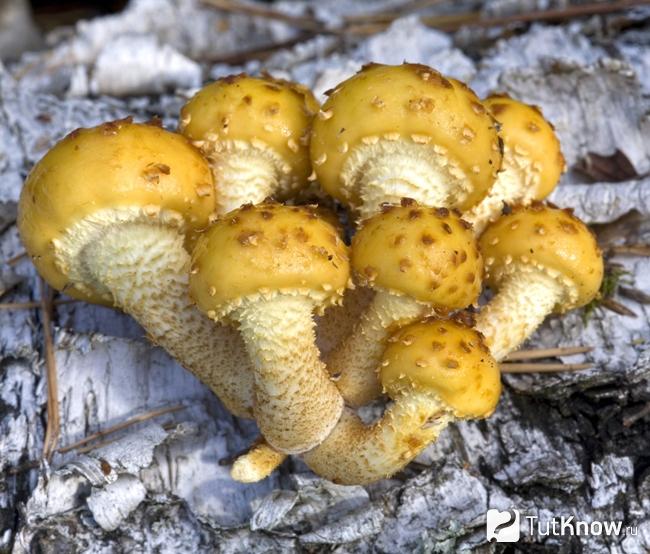
Despite the royal title, mushroom pickers do not favor golden flakes. Too high a risk of confusing an edible species with false mushrooms frightens inexperienced gatherers, and experienced collectors of forest gifts prefer more noble mushrooms - porcini or boletus, which do not have to be soaked or boiled before cooking.
Previously, golden flakes were valued much more. Mushrooms were included in the diet during numerous fasts - they contain so much calcium and phosphorus that they are an equivalent analogue of fish dishes.
It is interesting that, unlike honey agarics of other species, royal ones grow one by one or in small groups - up to 5-7 fruit chalk.
The scales of the golden cap can be prickly - this species is called willows, they grow on willow trunks. The hats of such mushrooms resemble rubber attachments for vibrating massagers.
Poisonous counterparts of royal honey agarics:
- Moth - a brighter hat, bitter flesh with a sweetish odor, mycelium inhabits fireplaces;
Scaly mucosa - an empty leg and a slimy, sticky, unpleasant to the touch surface of the cap;
Cinder scales - the skin on the cap is red, the leg is without a ring, on the base there are brown scales, the infant blanket, which remains on the edges of the cap, does not disappear.
Watch a video about golden flake:
Taste qualities
Many mushroom pickers are interested in the question of how to cook, how to clean ordinary scaly. After all, this mushroom has a specific taste. It is classified as conditionally edible mushroom. According to its taste characteristics, flake gets the 4th category.
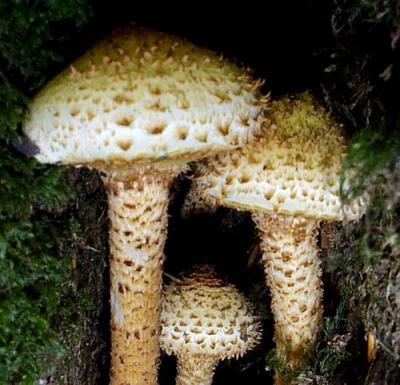
Some mushroom pickers believe that the presented mushroom should not be eaten. However, this is not the case
It is important to handle and assemble it correctly. Old mushrooms eat only caps.
If the specimen is young, its cap has not yet opened, you can cut it off along with the leg. Thanks to the abundant growth of mushrooms in one section of the tree, many caps can be collected in a short time. This is one of the advantages of the flake variety presented.
The pulp is tough enough. It has a bitter taste. To get rid of it, you need to boil the flakes for about 25 minutes. After that, it can be used to make pies, pickles. It is fried, soups are boiled, etc. This mushroom is especially tasty in a marinade with spices.
Golden scale recipes

Golden Scale Recipes:
Royal mushrooms in a slow cooker... In a modern multicooker pan, you can pre-cook royal mushrooms and prepare a main course. The washed mushrooms are laid out in a bowl, put on a simmer for 30 minutes, and then put on a steamer device. While the liquid is draining, chop the onion and carrots. Preheat the bowl on the "frying" mode and pour all the ingredients into it together. The dish can be tasted after 40 minutes - salt, pepper and add herbs to taste.
Salad with golden flakes... Boiled chicken fillet marinated in soy sauce. Boil diced potatoes, cut carrots. Pickled mushrooms are washed, cut into identical pieces. Stir potato cubes with carrots, mushrooms and fillet pieces. A large onion is cut into rings, each ring is rolled in flour, fried until golden brown, the parsley is washed and torn by hand. The salad is garnished with fried onion rings and parsley sprigs.
Growth features
Scale often bears fruit abundantly from July to September. Under comfortable climatic conditions, there are cases when the mushroom began to be harvested back in May. In color and appearance, honey mushrooms and common scaly have a distant similarity. Some mushroom pickers confuse them. Honey mushrooms in the autumn period become like scaly.

The difference between these two mushrooms is manifested in the absence of scales in honey agaric. Also, their flesh is never tough.
It is necessary to pay attention to this property of the mushroom when collecting. Also, scaly does not have poisonous imitators.
There is no need to fear that a mushroom brought in a basket that matches its description will be poisonous.
What does Cinder flake look like?
Cinder scaly got its name because of the scaly surface of the fruiting body. She belongs to plastic mushrooms. The plates are located at a small distance from each other, accrete with the leg, spores are located in them. In young specimens, the plates are gray, but as the spores grow and mature, the shade changes to clay-brown.
The photo below shows cinder flakes in a mature state, when the color of the plates has already acquired a brown tint.
Description of the hat
In young flakes, the coal-loving cap looks like a hemisphere, during growth it opens. The diameter is from 2 to 6 cm, the color is heterogeneous, brown with an orange tint, closer to the edges the color becomes lighter. The surface of the cap is sticky, shiny, and small, radial, fibrous scales. Due to the high humidity in wet and rainy weather, the skin of the cap becomes slippery, as it becomes covered with mucus, in the heat it is sticky and shiny. The edges are wavy, and in the center of the cap there is a wide truncated tubercle. The pulp is quite dense, at the break of a light yellow or light brown color.
Leg description
The leg is long, up to 60 mm in height and up to 10 mm in diameter. In the lower part it is covered with brown fibers, and on the top it has a lighter color, identical to the cap. The stem itself has small scales that range in color from reddish to brown. The area of the ring is highlighted in brown, but it quickly disappears, so the trace is almost invisible.
Growing scales at home
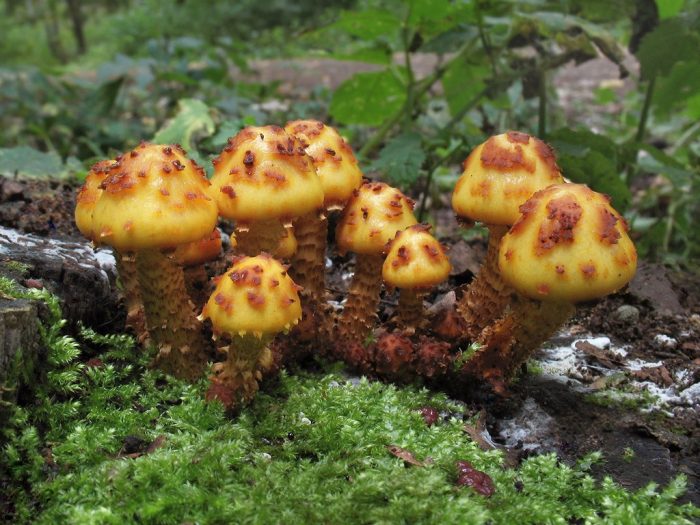
For the cultivation of flakes, substrates from wood processing industry waste are suitable, for example, sawdust of deciduous trees, chopped straw with the addition of sunflower husks, wheat bran, chopped corn cobs.
Such a substrate is formed into separate blocks, which are sterilized at a temperature of 100 ° C for 5 hours. Then it is moistened so that the humidity is 65-70%.
The mycelium of the fungus is planted in a substrate under sterile conditions, at temperatures up to 30 ° C.After that, the substrate is left in a room with a temperature of about 27 ° C for 2-3 weeks. Mushrooms do not need lighting during this period, but the air humidity should be 80%. Then the substrate overgrown with mycelium is transferred to a room with an air temperature of up to 11 ° C and a humidity of 98%
At the same time, it is important to ensure normal air exchange; it is impossible to leave the substrate in tight bags. When the first rudiments of fruiting bodies have appeared on the substrate, the air temperature is increased by 5 ° C, which stimulates the growth of fungi
They also slightly reduce humidity, by 5-10%. At this time, good lighting is needed for 10-12 hours a day.
The yield with this growing method is up to 30% of the mass of the original substrate.
In addition, flakes are grown on solid wood. For this, hemp or deciduous tree trunks are suitable. Use aspen, poplar, willow, birch, or fruit trees such as walnut, apple, plum.
The cuts are made in the wood, into which the mycelium is laid. The holes are made with a drill, at a distance of 15 cm from each other. Their depth is about 4 cm, diameter is up to 3 cm. You can also split the log lengthwise, pour a thin layer of mycelium into the resulting split, put the halves together and twist them tightly with wire.
Emergency medicine for mushroom poisoning
- Gastric lavage. At home, you should drink water and induce vomiting by pressing on the root of the tongue. In a hospital, this procedure is carried out using a probe.
- Cleansing enema. They bet if more than two hours have passed since the poisoning.
- Reception of adsorbents. Activated carbon, Enterosgel and other drugs will help to bind toxins and render them harmless.
- Drinking salted water or medications that work to combat dehydration. Water is drunk in small sips, often. The drugs are taken according to the instructions. When vomiting stops, the patient can be drunk with strong sweet tea.
- Wrapping. The victim must be warmed up. Hypothermia can occur due to severe dehydration. Warm blankets, heating pads, and complete rest are the first things to do when vomiting and diarrhea stop.
Composition and calorie content of golden flakes
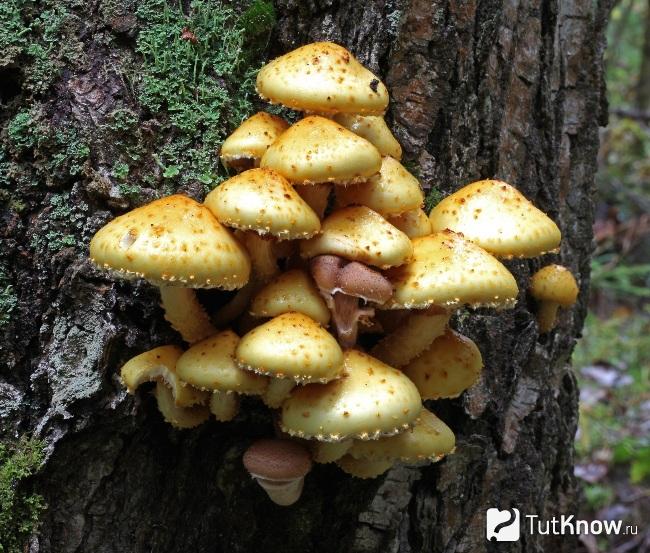
Royal mushrooms can be used in the diet of those who are losing weight, this helps to avoid breakdowns during the fasting period.
The calorie content of golden flakes is 22 kcal, of which:
- Proteins - 2.2 g;
- Fat - 1.2 g;
- Carbohydrates - 0.5 g;
- Dietary fiber - 5.1 g;
- Water - 89.1 g;
- Ash - 1 g.
Mono- and disaccharides per 100 g - 0.5 g.
The composition of the golden flake contains vitamins per 100 g:
- Vitamin B3 (PP) - 10.3 mg;
- Vitamin B1 (thiamine) - 0.02 mg;
- Vitamin B2 (riboflavin) - 0.38 mg;
- Vitamin C (ascorbic acid) - 11 mg;
- Vitamin E (alpha-tocopherol) 0.1 mg
- Vitamin PP (Niacin Equivalent) - 10.7 mg.
Minerals per 100 g:
- Calcium - 5 mg;
- Magnesium - 20 mg;
- Sodium - 5 mg;
- Potassium - 400 mg;
- Phosphorus - 45 mg;
- Iron - 0.8 mg.
This is not all useful composition. The golden flake contains folic and nicotinic acid, a tocopherol complex, and many amino acids.
Amino acids per 100 g:
- Threonine - 0.107 g;
- Leucine - 0.12 g;
- Lysine - 0.107 g;
- Valine - 0.232 g;
- Alanine - 0.199 g;
- Aspartic acid - 0.195 g;
- Glutamic acid - 0.343 g.
The action of nutrients is as follows:
- Vitamin B3 lowers cholesterol levels, stimulates the production of sex hormones, neutralizes hazardous substances, lowers blood sugar levels, breaks down proteins from food, and promotes the absorption of nutrients.
Vitamin B2 stimulates the production of hemoglobin, accelerates metabolic processes at the intercellular and intracellular levels, normalizes the functioning of the central and peripheral systems, and improves the function of reproductive organs.
Vitamin C is involved in all oxidative and reduction processes, increases the protective functions of the body, protects the walls of blood vessels from cholesterol deposits and the nervous system from stress.
Vitamin P relieves vascular spasms, regulates cholesterol levels, eliminates intoxication, reduces the level of triglycerides in the blood, neutralizes viruses, and increases the protective functions of the thyroid gland.
Magnesium strengthens the structure of muscle and nervous tissue, stimulates the growth and restoration of soft tissues at the cellular level, prevents the deposition of calculi in the kidneys and bile ducts, improves the structure of bone tissue, and digestive functions.
Potassium regulates the water-electrolyte balance, normalizes the work of the cardiovascular system, is responsible for the absorption of magnesium, and controls the level of sodium chloride.
Phosphorus - a protein component - is responsible for the metabolism of proteins, carbohydrates, lipids and proteins, participates in biosynthesis.
Royal mushrooms are used for culinary purposes, they are used as an ingredient in fungotherapy preparations. The properties of a mushroom growing in different conditions do not change, but the taste may differ. The golden scales collected in coniferous forests may taste a little bitter, but in deciduous ones they taste pleasant, the pulp may even be sweetish.
Types of scales
Common scaly (Pholiota squarrosa)
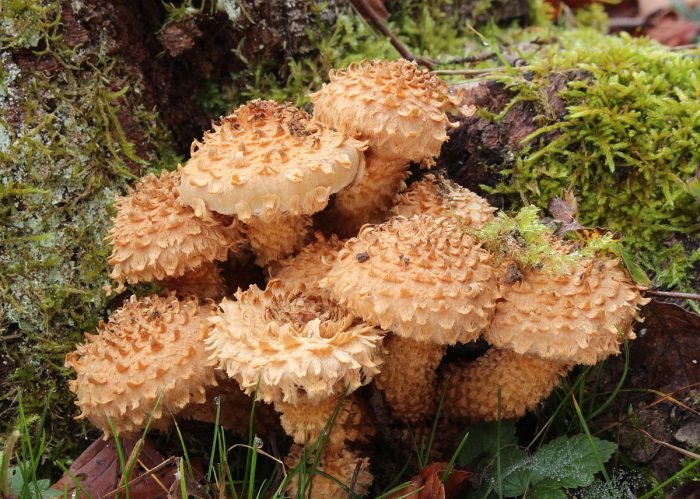
Edible mushroom.
The cap is 5-12 cm in diameter, hemispherical or conical, later convex and plano-convex, the edge is bent. The surface is covered with dry scales of a bright yellow color, slimy to the touch. The pulp is light yellow, has a faint earthy odor and a rare taste. The leg is 5-19 cm high, 1-3 cm thick, with a fibrous ring, whitish above, reddish-brown below, covered with a dark coating.
A widespread species, grows on living and dead wood of deciduous and coniferous trees.
Edible scale (Pholiota nameko)
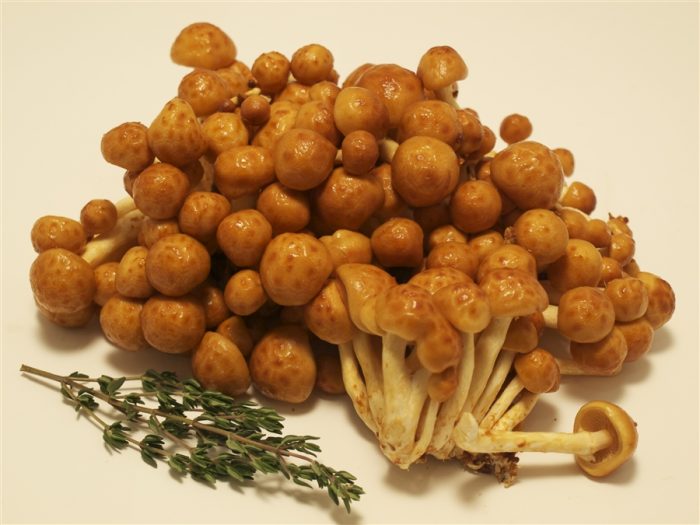
An edible mushroom used in Japanese cuisine for miso soup and pickled. It is cultivated in China and Japan.
The cap is small, 1-2 cm in diameter, orange-brown in color, covered with a slippery jelly-like substance. The mushroom grows in groups, on stumps and trees of broad-leaved species, for example, on beeches, like honey agarics, thin legs up to 5 cm high emerge from one base.
Alder scale (Pholiota alnicola)
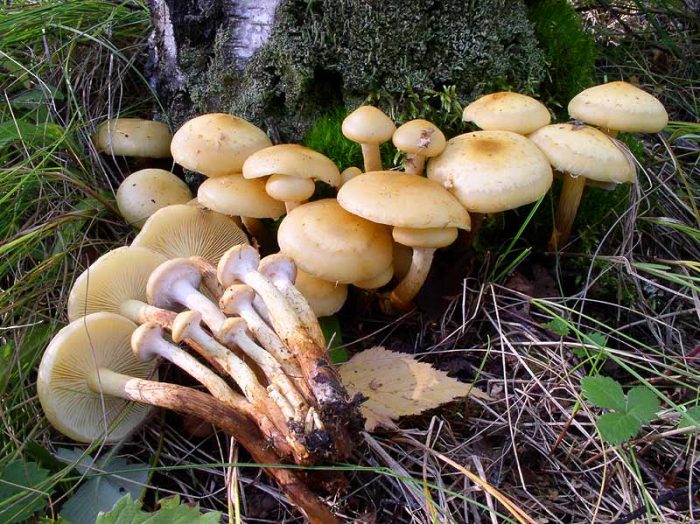
Edible mushroom.
The cap is 3-7 cm in diameter, the shape is narrowly convex, in mature mushrooms it becomes flat-convex, the edge is bent. The surface is slimy, lemon-yellow, olive-brown in the central part. The pulp is pale yellow, brownish in the stem, has a weak fruity odor, the taste is mealy, sparse. The leg is 3-13 cm high, 0.5-1 cm in diameter, in old mushrooms it is hollow, covered with a coating of white, yellow at the top, reddish-brownish at the bottom.
A parasitic fungus that grows on dead wood of deciduous trees, alder and willow.






